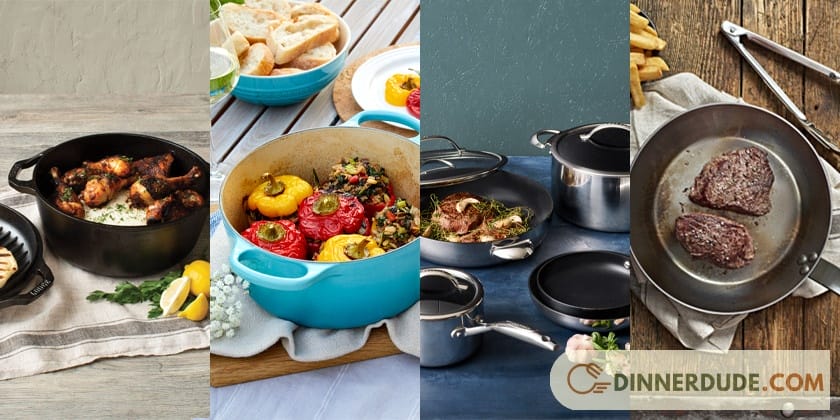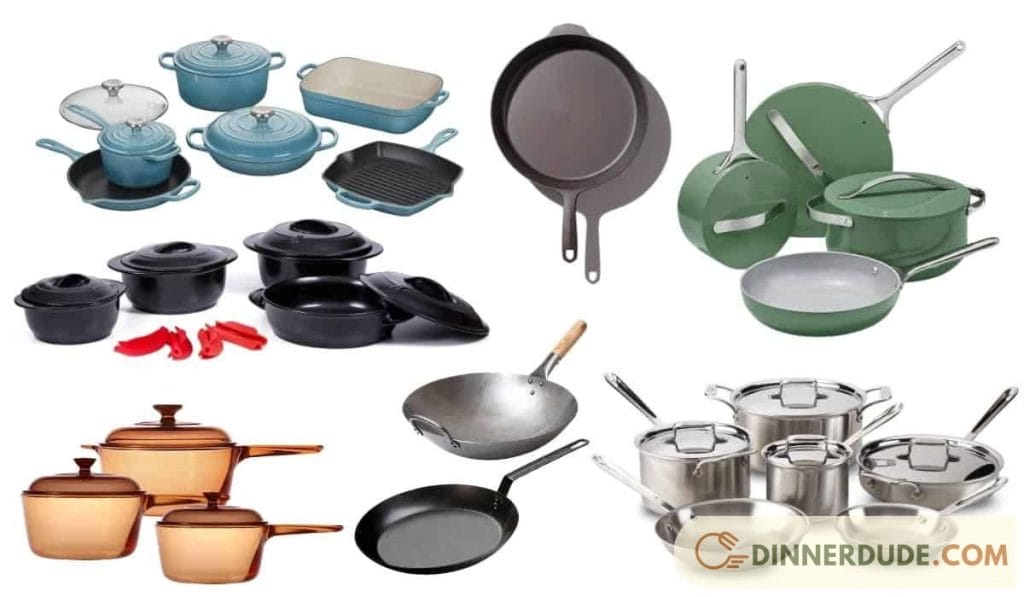Cookware selection is a crucial aspect of every kitchen, and concerns about the safety of different materials have become paramount. But, What cookware material is safest?
In this comprehensive guide, Dinnerdude will explore the various cookware materials available, dissecting their safety profiles and offering insights to help you make informed choices for a healthy and enjoyable cooking experience.
What cookware material is safest?
Choosing the safest cookware material is a crucial decision for health-conscious individuals.

Stainless Steel: A Stalwart of Safety
Stainless steel, renowned for its durability and resistance to corrosion, stands out as a stalwart in the realm of cookware safety.
This non-reactive material does not leach harmful substances into your food, ensuring that your culinary creations remain uncontaminated. Its versatility and ease of maintenance make stainless steel an excellent choice for those prioritizing both safety and practicality in their kitchen.
Cast Iron: A Time-Tested Classic
Cast iron, a time-tested classic, not only boasts excellent heat retention but is also revered for its safety.
As it doesn’t contain the chemical coatings found in some modern cookware, the risk of exposure to potentially harmful substances is minimized.
With proper seasoning and maintenance, cast iron cookware can be a safe and reliable addition to your kitchen arsenal.
Copper: Elegance and Safety
While copper cookware is celebrated for its exceptional heat conductivity and aesthetic appeal, its safety can be a nuanced consideration.
Copper has the potential to leach into certain foods, particularly acidic ones, posing health concerns.
To mitigate risks, copper cookware is often lined with stainless steel or tin, emphasizing the importance of understanding the construction of your copper cookware for safe usage.
Aluminum: Balancing Affordability and Caution
Aluminum cookware, known for its affordability and excellent heat conductivity, raises concerns about potential health risks. The possibility of aluminum leaching into food, especially in acidic or salty dishes, has sparked debates.
While the amount of leaching is generally considered minimal, individuals with health concerns may opt for alternative materials to err on the side of caution.
The Landscape of Non-Stick Cookware

Non-stick cookware has become a staple in kitchens worldwide, offering convenience in cooking and cleaning.
However, the landscape of non-stick options presents a nuanced journey, with different materials and coatings influencing safety considerations.
Ceramic Non-Stick: A Contemporary and Safer Option
For those looking for non-stick options, ceramic cookware has become popular as a modern and safer alternative.
The ceramic non-stick coating is free of harmful substances such as PFOA and PTFE, providing a healthy solution. This type of cookware has a non-toxic, scratch-resistant surface that makes cooking and cleaning easy.
However, it’s essential to handle these coatings with care to prevent damage and ensure their longevity.
While considering the safest cookware materials, personal preferences and cooking habits should be taken into account, ensuring that the chosen option suits both health and culinary needs.
The Controversy of Traditional Non-Stick Coatings
Traditional non-stick coatings, often containing PFOA and PTFE, have raised concerns about potential health risks when exposed to high temperatures.
While convenient, these coatings may release harmful fumes and deteriorate over time.
Choosing high-quality non-stick options and using them within recommended temperature limits can help mitigate these risks.

In the quest for the safest cookware material, the landscape offers a diverse array of options, each with its unique characteristics. Stainless steel and cast iron stand as steadfast pillars of safety, while ceramic non-stick coatings provide a modern and health-conscious alternative.
Navigating the complexities of non-stick coatings requires a discerning eye and adherence to usage guidelines. By combining knowledge about these materials with mindful cooking practices, you can craft a safe culinary haven where your health and enjoyment coexist harmoniously.